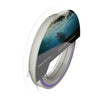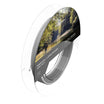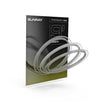Euro Nymphing in Croatia
I have never been to Croatia before, and as such I travelled with what can only be described as an armoury of flies. Boxes of various nymphs and dries from sparse light 20’s and 22’s to much larger nymphs and dries up to 12’s with big beds for faster and deeper water. When you don’t know what to expect I find it better to be over rather than underprepared. If you have everything including the kitchen sink then you can’t be surprised on a new water, being prepared for hatch or eventuality. But! You don’t have to take everything on the water with you. I usually take a small selection of nymphs and dries in a box of which are most likely to be hatching on that particular day. Then if needs be, I can head back to the car and grab more flies if the hatches change. It’s better to be safe than sorry, especially when the fish get fixated on that one fly you don’t have!
Croatian rivers have a single fly only policy, and thus my usual process of trial and error with patterns was elongated tenfold. Where I would normally fish 2 or 3 patterns I was restricted to a single nymph or dry fly. However, due to sight fishing, I was able to tell relatively quickly whether my offerings would be accepted or rejected and change accordingly. I crept up the middle of the river in search of small groups of fish. The larger Kupa grayling were either solitary or in groups of 2, 3 or even 4 fish. If the fish liked the fly, then they would be more likely to take if they were competing with others…or so I thought…
Using a French Leader
The first group of fish I came across were sat in formation moving from side to side taking small nymphs quite happily before returning to their respective positions. They were all huddled together on a small patch of gravel situated in between two large slabs of flat rock. Seemingly throughout the trip, I didn’t see a single fish on the flat rock. They either stayed on the edges of the river in the boulders and gravel or situated themselves on gravel patches in between like these ones. When I had finished pondering over their behaviour, I made a long cast on a French nymph leader. French nymphing is a good method for targeting fish in clear rivers, because it presents the fly softly with minimal surface disturbance, unlike a conventional fly line. It also allows you to maintain distance between yourself and the fish and present the fly without the risk of spooking the fish.
My fly of choice was a size 14 pheasant tail Frenchie. One of my favourite grayling nymphs! Natural with a hint of colour for a trigger point. With a 3.5mm bead the fly made a small plop when it hit the water’s surface. The fish didn’t react to the disturbance and carried on as normal until the fly came close. As it drifted through them, they all seemed to simultaneously drift away from the fly before returning to their original positions once it had passed through. Confused by the reaction I placed another cast which was met with the grayling spooking off completely. I was confused by the reaction as the very same fly had caught a number of grayling on the trip for me already…

A change of tactics
I continued to fish, blind casting this time, and Czech nymphing in the various runs and seems around me while I looked for more fish. Czech nymphing techniques work well in areas of faster flow, as the disturbance on the top of the water disguises the angler somewhat and allows you to get much closer to the fish (as long as you wade carefully). As I moved up the river, I picked up several smaller grayling. It wasn’t the pattern that was at fault so what could it be…? About 20 yards upstream I came across a few nice sections of pocket water with submerged boulders which seemed to provide a good resting place for some more larger grayling. At last!
However, this time I wanted to try something different. There were some very nice fish mixed in with this group and I wanted to get it right first time. I opened my nymph box and saw the Frenchie that I had been using but in a size 18. I knew the pattern worked as I had landed a number of smaller fish, but I just wondered if it was the size of the fly that put the larger fish off. My question was answered on my first cast. I covered a nice fish in between two submerged boulders and it moved to take the fly immediately! This fish was followed by another 3 from the same area, all in the range of 35-40cm. So, was it a case of the size of the fly or just the pattern itself? I continued in the pocket water picking up fish all the way through, before a short move up the river saw a much larger grayling sat on its own on the middle in a deep hole. I changed fly to another size 18 but this time an olive thread nymph. Something a little more natural this time. As with most large fish, they’re that big for a reason!

Due to the size of the fly, it only had a 2.5mm bead on. So, to reach the depth of the fish I had to cast much further upstream of it than I normally would to allow it to drop in time. On the first pass the fish looked at the fly but decided not to eat straight away. However, due to the interest I left the fly to continue the drift and the grayling doubled back and ate it. So, it was the size that was key! I continued the day messing around with various patterns, with the same resounding conclusion. As long as the fly was a size 16 or below it would get eaten!
The evening rise
After heading off for dinner, Carl and I returned to fish the evening rise. There was a flurry of small sedges on the water and the grayling were going batty. I set up a floating line, with a Sunray tapered leader and a small size 14 retirer sedge. One of my favourite sedge patterns that has caught me fish all over the UK and abroad. I covered a number of fish with it but they either ignored it or splashed the fly but didn’t take. My leader was sub surface and my presentation was good, but the refusals continued. So, I thought back to earlier in the day and dropped down to a size 16. The sedges flying around were in the range of size 14 to 16, but it seemed the fish wanted a smaller offering. After my change I put another dozen or so fish in the net to end a fantastic day.
It just goes to show that if fish are refusing a fly it may not be the pattern but the size that is not right. A simple decrease or in some cases increase in fly size can often make the difference between a good day and a great one.
































